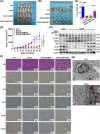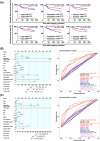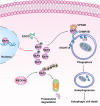Cytoplasmic YAP1-mediated ESCRT-III assembly promotes autophagic cell death and is ubiquitinated by NEDD4L in breast cancer
- PMID: 37005481
- PMCID: PMC10174091
- DOI: 10.1002/cac2.12417
Cytoplasmic YAP1-mediated ESCRT-III assembly promotes autophagic cell death and is ubiquitinated by NEDD4L in breast cancer
Abstract
Background: Nuclear Yes1-associated transcriptional regulator (YAP1) promotes tumor progression. However, the function of cytoplasmic YAP1 in breast cancer cells and its impact on the survival of breast cancer patients remain unclear. Our research aimed to explore the biological function of cytoplasmic YAP1 in breast cancer cells and the possibility of cytoplasmic YAP1 as a predictive marker of breast cancer survival.
Methods: We constructed cell mutant models, including NLS-YAP15SA (nuclear localized), YAP1S94A (incapable of binding to the TEA domain transcription factor family) and YAP1S127D (cytoplasmic localized), and used Cell Counting Kit-8 (CCK-8) assays, 5-ethynyl-2'-deoxyuridine (EdU) incorporation assays, and Western blotting (WB) analysis to detect cell proliferation and apoptosis. The specific mechanism of cytoplasmic YAP1-mediated endosomal sorting complexes required for transport III (ESCRT-III) assembly was studied by co-immunoprecipitation, immunofluorescence staining, and WB analysis. Epigallocatechin gallate (EGCG) was used to simulate YAP1 retention in the cytoplasm in in vitro and in vivo experiments to study the function of cytoplasmic YAP1. YAP1 binding to NEDD4-like E3 ubiquitin protein ligase (NEDD4L) was identified using mass spectrometry and was verified in vitro. Breast tissue microarrays were used to analyze the relationship between cytoplasmic YAP1 expression and the survival of breast cancer patients.
Results: YAP1 was mainly expressed in the cytoplasm in breast cancer cells. Cytoplasmic YAP1 promoted autophagic death of breast cancer cells. Cytoplasmic YAP1 bound to the ESCRT-III complex subunits charged multivesicular body protein 2B (CHMP2B) and vacuolar protein sorting 4 homolog B (VPS4B), promoting assembly of CHMP2B-VPS4B and activating autophagosome formation. EGCG retained YAP1 in the cytoplasm, promoting the assembly of CHMP2B-VPS4B to promote autophagic death of breast cancer cells. YAP1 bound to NEDD4L, and NEDD4L mediated ubiquitination and degradation of YAP1. Breast tissue microarrays revealed that high levels of cytoplasmic YAP1 were beneficial to the survival of breast cancer patients.
Conclusions: Cytoplasmic YAP1 mediated autophagic death of breast cancer cells by promoting assembly of the ESCRT-III complex; furthermore, we established a new breast cancer survival prediction model based on cytoplasmic YAP1 expression.
Keywords: Autophagosome closure; Autophagy; Breast cancer; CHMP2B; Cytoplasmic YAP1; EGCG; ESCRT-III; Hippo pathway; NEDD4L; Ubiquitin; VPS4B.
© 2023 The Authors. Cancer Communications published by John Wiley & Sons Australia, Ltd. on behalf of Sun Yat-sen University Cancer Center.
Conflict of interest statement
The authors declare no conflict of interest.
Figures










Similar articles
-
YAP1 recruits c-Abl to protect angiomotin-like 1 from Nedd4-mediated degradation.PLoS One. 2012;7(4):e35735. doi: 10.1371/journal.pone.0035735. Epub 2012 Apr 27. PLoS One. 2012. PMID: 22558212 Free PMC article.
-
MAPT/Tau accumulation represses autophagy flux by disrupting IST1-regulated ESCRT-III complex formation: a vicious cycle in Alzheimer neurodegeneration.Autophagy. 2020 Apr;16(4):641-658. doi: 10.1080/15548627.2019.1633862. Epub 2019 Jun 28. Autophagy. 2020. PMID: 31223056 Free PMC article.
-
Charged multivesicular body protein 2B (CHMP2B) of the endosomal sorting complex required for transport-III (ESCRT-III) polymerizes into helical structures deforming the plasma membrane.J Biol Chem. 2011 Nov 18;286(46):40276-86. doi: 10.1074/jbc.M111.283671. Epub 2011 Sep 16. J Biol Chem. 2011. PMID: 21926173 Free PMC article.
-
ESCRT functions in autophagy and associated disease.Cell Cycle. 2008 May 1;7(9):1166-72. doi: 10.4161/cc.7.9.5784. Epub 2008 Feb 11. Cell Cycle. 2008. PMID: 18418046 Review.
-
The role of CHMP2BIntron5 in autophagy and frontotemporal dementia.Brain Res. 2016 Oct 15;1649(Pt B):151-157. doi: 10.1016/j.brainres.2016.02.051. Epub 2016 Mar 10. Brain Res. 2016. PMID: 26972529 Free PMC article. Review.
Cited by
-
Nephronectin (NPNT) is a Crucial Determinant of Idiopathic Pulmonary Fibrosis: Modulating Cellular Senescence via the ITGA3/YAP1 Signaling Axis.Adv Sci (Weinh). 2025 Aug;12(32):e01956. doi: 10.1002/advs.202501956. Epub 2025 May 30. Adv Sci (Weinh). 2025. PMID: 40444575 Free PMC article.
-
Autophagy Dysfunction: The Kernel of Hair Loss?Clin Cosmet Investig Dermatol. 2024 May 20;17:1165-1181. doi: 10.2147/CCID.S462294. eCollection 2024. Clin Cosmet Investig Dermatol. 2024. PMID: 38800357 Free PMC article. Review.
-
Target identification of natural products in cancer with chemical proteomics and artificial intelligence approaches.Cancer Biol Med. 2025 Jul 9;22(6):549-97. doi: 10.20892/j.issn.2095-3941.2025.0145. Cancer Biol Med. 2025. PMID: 40631551 Free PMC article. Review.
-
Comprehensive analysis of ESCRT transcriptome-associated signatures and identification of the regulatory role of LMO7-AS1 in osteosarcoma.Cancer Cell Int. 2025 Jan 30;25(1):29. doi: 10.1186/s12935-025-03659-4. Cancer Cell Int. 2025. PMID: 39885569 Free PMC article.
-
Role and therapeutic potential of the NEDD4 family in breast cancer.Front Pharmacol. 2025 Jun 4;16:1587675. doi: 10.3389/fphar.2025.1587675. eCollection 2025. Front Pharmacol. 2025. PMID: 40535763 Free PMC article. Review.
References
-
- Siegel RL, Miller KD, Fuchs HE, Jemal A. Cancer statistics, 2022. CA Cancer J Clin. 2022;72(1):7–33. - PubMed
MeSH terms
Substances
LinkOut - more resources
Full Text Sources
Medical

